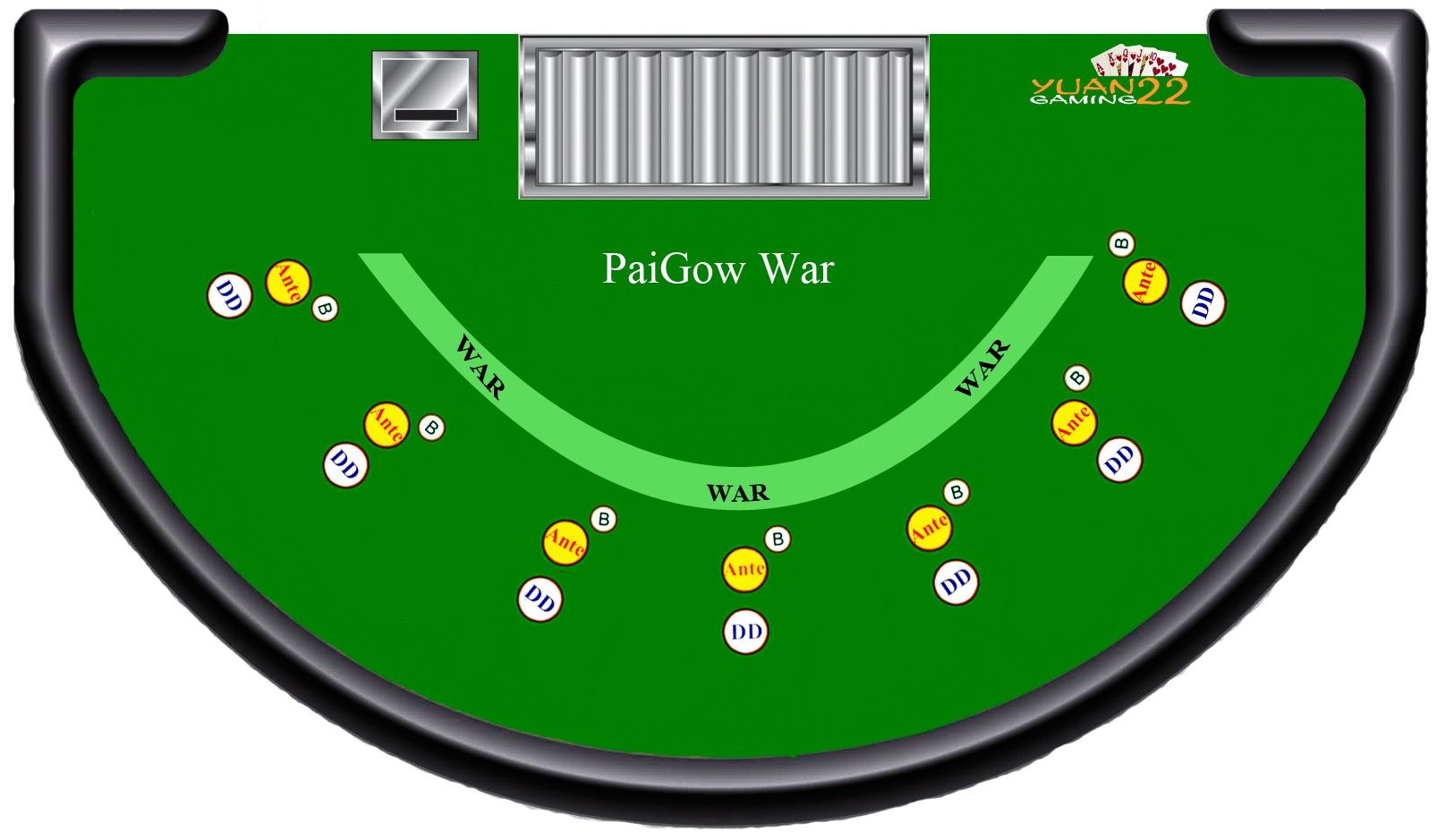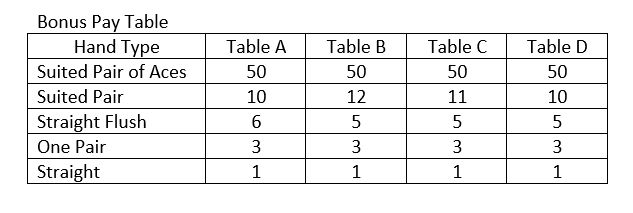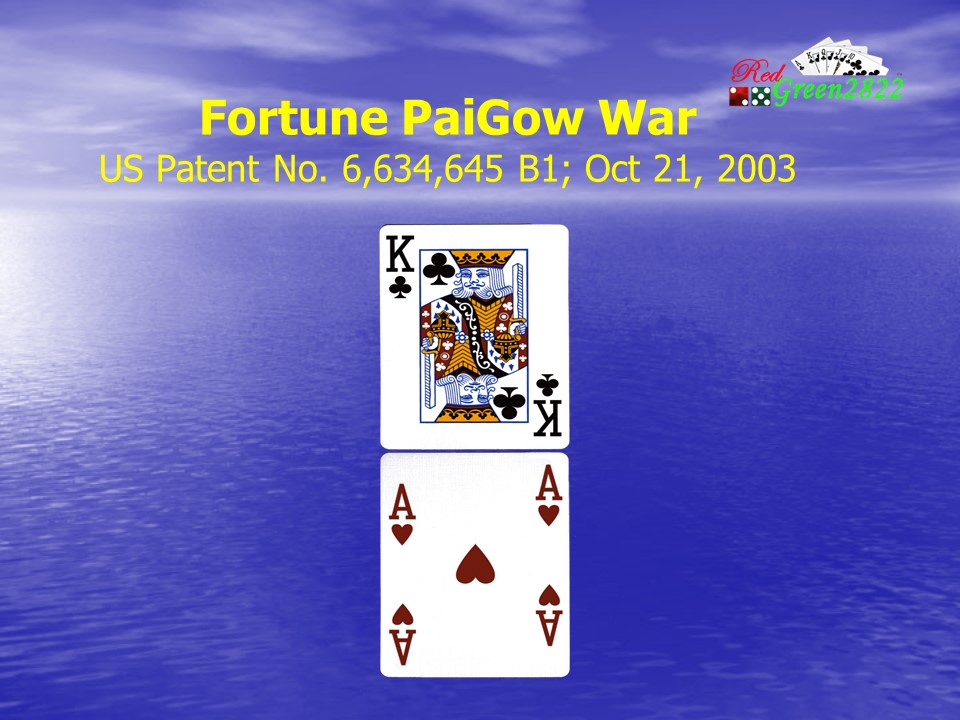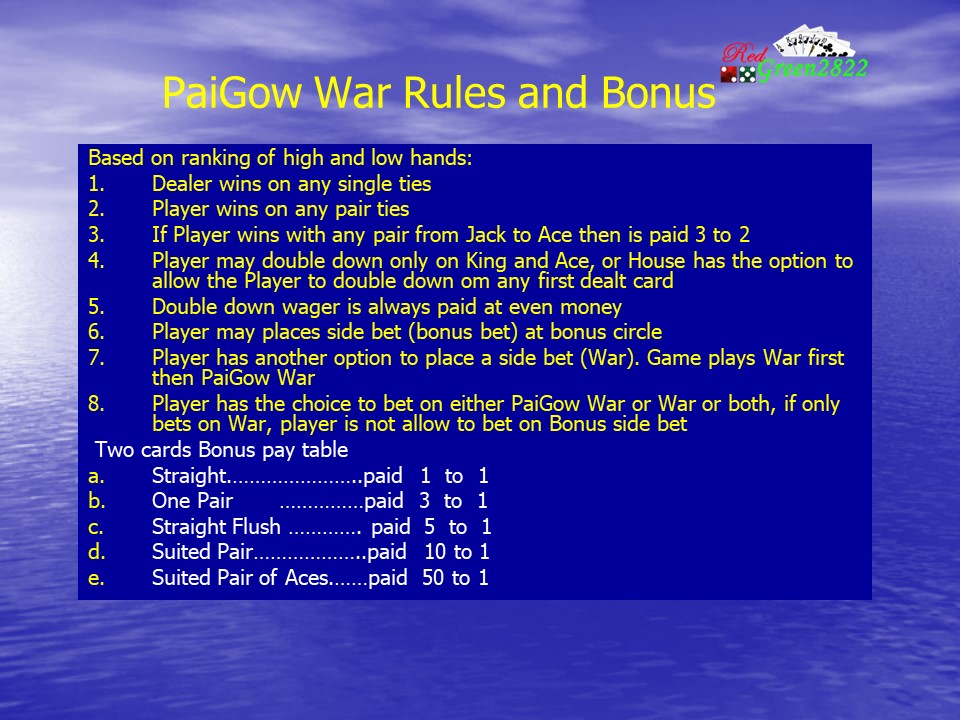PaiGow War
Layout

ANALYSIS
Two Card Pai Gow (PaiGow War) First Version
2 Card Pai Gow is a new casino table game similar to Pai Gow Poker. It is played with 6 standard decks of cards. All players compete against the dealer.
Rules of Play
The object of the game is to beat the dealer’s low and high hands.
The game begins with each player making a wager. The dealer deals two cards to each player and two cards face down to himself. The player now arranges their 2 cards into a low card hand and a high card hand. The low hand must not be higher than the high hand.
After all players have set their hands, the dealer turns over his two cards and arranges them into a low hand and a high hand. The dealer now compares his low hand with the player’s low hand and his high hand with the player’s high hand. In the event of a copy hand, the dealer wins. An ace is the highest and a 2 is the lowest card. The player wins the bet only if both his low and high hands win.
A pair beats any non-pair hand. If both the player and the dealer have a pair, the higher pair wins, but the player wins if both have the same pair. A player’s winning pair of 9s or higher will be paid 2 to 1 and any other winning pairs pay 3 to 2.
Three examples are given below:
1)
Player 9-Q
Dealer 5-K
Outcome: Push
2)
Player 9-Q
Dealer 9-K
Outcome: Loss
3)
Player 9-A
Dealer 7-J
Outcome: Win
4)
Player 5-5
Dealer 7-Q
Outcome: Win (3 to 2)
There is no commission charge on any player winning hands.
A computer program was written to cycle through all possible player-dealer hand combinations and determined the player’s expectation. The probability distribution and the expected return are shown below:

A computer simulation of 500 millions hands was run to verify the accuracy of the analysis.
Presented By: Stanley Ko
GAMBOLOGY – PO Box 82225 – Las Vegas, NV 89180 – (702) 258-9685
November 24, 2003
ANALYSIS
Pai Gow War Second version
Pai Gow War is a new casino table game similar to Pai Gow Poker. It is played with 6 or 7 standard decks of cards. All players compete against the dealer.
Rules of Play
The object of the game is to beat the dealer’s low and high hands.
The game begins with each player making a wager. The dealer deals one card to each player and himself. If a player’s first card is a King or Ace, he has the option to double down by matching his original wager. Otherwise, the player can simply stay in the game with his original wager. After all players have made their decisions, the dealer will deal one more card to each player and himself. The player now arranges their 2 cards into a low card hand and a high card hand. The low hand must not be higher than the high hand.
After all players have set their hands, the dealer turns over his two cards and arranges them into a low hand and a high hand. An ace is the highest and a 2 is the lowest card. The dealer now compares his low hand with the player’s low hand and his high hand with the player’s high hand. In the event of a copy hand, the dealer wins. The player wins only if both his low and high hands win. If one hand wins and the other loses, the hand is a push. There is no commission charge on any player winning hands.
A pair beats any non-pair hand. If both the player and the dealer have a pair, the higher pair wins, but the player wins if both have the same pair. All wagers including the double down wager are paid even money. However, a player with a winning pair of Jacks or higher will be paid 3 to 2 on the original wager. Some examples are given below:
1) Player 9-Q vs. Dealer 5-K
Outcome: Push
2) Player 9-Q vs. Dealer 9-K
Outcome: Loss
3) Player 9-A vs. Dealer 7-J
Outcome: Win
4) Player J-J vs. Dealer 7-Q
Outcome: Win (3 to 2 on original wager)
Bonus Bet
The player has the option of placing a Bonus bet. The Bonus bet will win if the player’s two cards form a pair, a straight or a straight flush. The Bonus pay tables are shown below:

A computer program was written to cycle through all possible player-dealer hand combinations and determined the player’s expectation. The probability distribution and the expected return are shown below:

The winning frequency is 31.47% and the player would double down 15.38% of the time.
The house advantage is 2.34% of the original wager or 2.03% per total wager.

The winning frequency is 31.47% and the player would double down 15.38% of the time.
The house advantage is 2.39% of the original wager or 2.07% per total wager.
A computer simulation of 500 millions hands was run to verify the accuracy of the analysis.
Bonus Bet


Presented By: Stanley Ko
BetWiser Games – PO Box 82225 – Las Vegas, NV 89180 – (702) 258-9685
July 14, 2010

